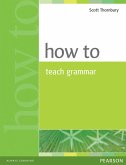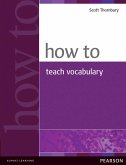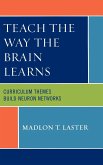Schade – dieser Artikel ist leider ausverkauft. Sobald wir wissen, ob und wann der Artikel wieder verfügbar ist, informieren wir Sie an dieser Stelle.
- Broschiertes Buch
- Merkliste
- Auf die Merkliste
- Bewerten Bewerten
- Teilen
- Produkt teilen
- Produkterinnerung
- Produkterinnerung
Focusing on curriculum leadership and closing the achievement gap, this influential book is updated with new insights on developing and aligning curriculum in a standards-based environment.
Andere Kunden interessierten sich auch für
![Why and How to Teach Music Composition Why and How to Teach Music Composition]() Why and How to Teach Music Composition75,99 €
Why and How to Teach Music Composition75,99 €![How to Teach Grammar How to Teach Grammar]() Scott ThornburyHow to Teach Grammar59,99 €
Scott ThornburyHow to Teach Grammar59,99 €![How to Teach Vocabulary How to Teach Vocabulary]() Scott ThornburyHow to Teach Vocabulary59,99 €
Scott ThornburyHow to Teach Vocabulary59,99 €![How to Teach Business English How to Teach Business English]() Evan FrendoHow to Teach Business English40,99 €
Evan FrendoHow to Teach Business English40,99 €![It's Not What You Teach But How It's Not What You Teach But How]() Nancy SullaIt's Not What You Teach But How111,99 €
Nancy SullaIt's Not What You Teach But How111,99 €![How to Teach Literature - and Still Love Reading How to Teach Literature - and Still Love Reading]() Heather HolmesHow to Teach Literature - and Still Love Reading15,99 €
Heather HolmesHow to Teach Literature - and Still Love Reading15,99 €![Teach the Way the Brain Learns Teach the Way the Brain Learns]() Madlon T. LasterTeach the Way the Brain Learns125,99 €
Madlon T. LasterTeach the Way the Brain Learns125,99 €-
-
Focusing on curriculum leadership and closing the achievement gap, this influential book is updated with new insights on developing and aligning curriculum in a standards-based environment.
Produktdetails
- Produktdetails
- Verlag: Corwin
- Seitenzahl: 168
- Erscheinungstermin: 7. Juni 2010
- Englisch
- Abmessung: 229mm x 152mm x 9mm
- Gewicht: 254g
- ISBN-13: 9781412960137
- ISBN-10: 1412960134
- Artikelnr.: 30469842
- Herstellerkennzeichnung
- Libri GmbH
- Europaallee 1
- 36244 Bad Hersfeld
- gpsr@libri.de
- Verlag: Corwin
- Seitenzahl: 168
- Erscheinungstermin: 7. Juni 2010
- Englisch
- Abmessung: 229mm x 152mm x 9mm
- Gewicht: 254g
- ISBN-13: 9781412960137
- ISBN-10: 1412960134
- Artikelnr.: 30469842
- Herstellerkennzeichnung
- Libri GmbH
- Europaallee 1
- 36244 Bad Hersfeld
- gpsr@libri.de
Fenwick W. English (Ph.D.) is the R. Wendell Eaves Senior Distinguished Professor of Educational Leadership in the School of Education at the University of North Carolina at Chapel Hill, a position he has held since 2001. As a scholar/practitioner he has held positions as a school principal and superintendent of schools in California and New York and as a department chair, dean, and vice-chancellor of academic affairs at universities in Ohio and Indiana. He is the former President of the University Council of Educational Administration (UCEA) and of the National Council of Professors of Educational Administration (NCPEA). His research has been reported in national and international academic forums. He edited the 2006 SAGE Encyclopedia of Educational Leadership and Administration, the 2009 SAGE Library of Educational Thought and Practice: Educational Leadership and Administration; and the 2011 SAGE Handbook of Educational Leadership (2nd Ed.). In 2013, he received the Living Legend Award from NCPEA for his lifetime contribution to the field of educational leadership.
Preface: America's Continuing Educational Canterbury Tales
Acknowledgments
About the Author
Introduction to the Third Edition
1. The Function of Curriculum in Schools
1.1 What Is Curriculum?
1.2 Curriculum Design and Delivery
1.3 Curriculum Coordination and Articulation
1.4 Combining Design and Delivery Issues in Schools
1.5 Formal, Informal, and the Hidden Curriculum
1.6 Curriculum and the Cultural Arbitrary
1.7 Conventional Practices and Complaints About Curriculum
1.8 The Necessary Requirements of an Imperfect Curriculum
1.9 A Clarifying Model of the Critical Curricular Relationships and Terms
2. A Template for Curriculum Construction
2.1 The Traditional View of Developing Curriculum
2.2 Using a Needs Assessment to Develop a Curricular Framework
2.3 Constructing Curriculum With Gap Data
2.4 Constructing "User Friendly" Curriculum Work Plans
2.5 Moving From Curriculum Content to Work Tasks
2.6 Constructing "User Friendly" Curriculum Guides
2.7 Essential Elements in Curriculum Guides
2.8 Setting Content Priorities and Expressing Time Values
2.9 A Word About Sequence and Stress
2.10 A Recommended Curriculum Guide Format
3. Aligning the Curriculum
3.1 The Process of Alignment by Frontloading
3.2 The Process of Alignment via Backloading
3.3 How to Do Alignment
3.4 Other Issues in the Alignment Procedure
4. The Challenge of Curriculum Leadership in the Teaching and Testing Nexus
4.1 Considering The Full Responsibility for Curriculum Leadership
4.2 Who Benefits From the Perpetuation of the Cultural Capital Embraced by
State Imposed Accountability Models?
4.3 Avoiding Deficit Mindsets, Models, and Cultural Marginalization of
Others
4.4 Not All Data Are Valuable or Relevant
4.5 Avoiding Outmoded Management Models
4.6 Understanding the Drawbacks of Top-Down Supervisory Approaches
4.7 The Nexus of Curriculum Leadership
4.8 Some Concluding Thoughts
Glossary of Terms
References
Index
Acknowledgments
About the Author
Introduction to the Third Edition
1. The Function of Curriculum in Schools
1.1 What Is Curriculum?
1.2 Curriculum Design and Delivery
1.3 Curriculum Coordination and Articulation
1.4 Combining Design and Delivery Issues in Schools
1.5 Formal, Informal, and the Hidden Curriculum
1.6 Curriculum and the Cultural Arbitrary
1.7 Conventional Practices and Complaints About Curriculum
1.8 The Necessary Requirements of an Imperfect Curriculum
1.9 A Clarifying Model of the Critical Curricular Relationships and Terms
2. A Template for Curriculum Construction
2.1 The Traditional View of Developing Curriculum
2.2 Using a Needs Assessment to Develop a Curricular Framework
2.3 Constructing Curriculum With Gap Data
2.4 Constructing "User Friendly" Curriculum Work Plans
2.5 Moving From Curriculum Content to Work Tasks
2.6 Constructing "User Friendly" Curriculum Guides
2.7 Essential Elements in Curriculum Guides
2.8 Setting Content Priorities and Expressing Time Values
2.9 A Word About Sequence and Stress
2.10 A Recommended Curriculum Guide Format
3. Aligning the Curriculum
3.1 The Process of Alignment by Frontloading
3.2 The Process of Alignment via Backloading
3.3 How to Do Alignment
3.4 Other Issues in the Alignment Procedure
4. The Challenge of Curriculum Leadership in the Teaching and Testing Nexus
4.1 Considering The Full Responsibility for Curriculum Leadership
4.2 Who Benefits From the Perpetuation of the Cultural Capital Embraced by
State Imposed Accountability Models?
4.3 Avoiding Deficit Mindsets, Models, and Cultural Marginalization of
Others
4.4 Not All Data Are Valuable or Relevant
4.5 Avoiding Outmoded Management Models
4.6 Understanding the Drawbacks of Top-Down Supervisory Approaches
4.7 The Nexus of Curriculum Leadership
4.8 Some Concluding Thoughts
Glossary of Terms
References
Index
Preface: America's Continuing Educational Canterbury Tales
Acknowledgments
About the Author
Introduction to the Third Edition
1. The Function of Curriculum in Schools
1.1 What Is Curriculum?
1.2 Curriculum Design and Delivery
1.3 Curriculum Coordination and Articulation
1.4 Combining Design and Delivery Issues in Schools
1.5 Formal, Informal, and the Hidden Curriculum
1.6 Curriculum and the Cultural Arbitrary
1.7 Conventional Practices and Complaints About Curriculum
1.8 The Necessary Requirements of an Imperfect Curriculum
1.9 A Clarifying Model of the Critical Curricular Relationships and Terms
2. A Template for Curriculum Construction
2.1 The Traditional View of Developing Curriculum
2.2 Using a Needs Assessment to Develop a Curricular Framework
2.3 Constructing Curriculum With Gap Data
2.4 Constructing "User Friendly" Curriculum Work Plans
2.5 Moving From Curriculum Content to Work Tasks
2.6 Constructing "User Friendly" Curriculum Guides
2.7 Essential Elements in Curriculum Guides
2.8 Setting Content Priorities and Expressing Time Values
2.9 A Word About Sequence and Stress
2.10 A Recommended Curriculum Guide Format
3. Aligning the Curriculum
3.1 The Process of Alignment by Frontloading
3.2 The Process of Alignment via Backloading
3.3 How to Do Alignment
3.4 Other Issues in the Alignment Procedure
4. The Challenge of Curriculum Leadership in the Teaching and Testing Nexus
4.1 Considering The Full Responsibility for Curriculum Leadership
4.2 Who Benefits From the Perpetuation of the Cultural Capital Embraced by
State Imposed Accountability Models?
4.3 Avoiding Deficit Mindsets, Models, and Cultural Marginalization of
Others
4.4 Not All Data Are Valuable or Relevant
4.5 Avoiding Outmoded Management Models
4.6 Understanding the Drawbacks of Top-Down Supervisory Approaches
4.7 The Nexus of Curriculum Leadership
4.8 Some Concluding Thoughts
Glossary of Terms
References
Index
Acknowledgments
About the Author
Introduction to the Third Edition
1. The Function of Curriculum in Schools
1.1 What Is Curriculum?
1.2 Curriculum Design and Delivery
1.3 Curriculum Coordination and Articulation
1.4 Combining Design and Delivery Issues in Schools
1.5 Formal, Informal, and the Hidden Curriculum
1.6 Curriculum and the Cultural Arbitrary
1.7 Conventional Practices and Complaints About Curriculum
1.8 The Necessary Requirements of an Imperfect Curriculum
1.9 A Clarifying Model of the Critical Curricular Relationships and Terms
2. A Template for Curriculum Construction
2.1 The Traditional View of Developing Curriculum
2.2 Using a Needs Assessment to Develop a Curricular Framework
2.3 Constructing Curriculum With Gap Data
2.4 Constructing "User Friendly" Curriculum Work Plans
2.5 Moving From Curriculum Content to Work Tasks
2.6 Constructing "User Friendly" Curriculum Guides
2.7 Essential Elements in Curriculum Guides
2.8 Setting Content Priorities and Expressing Time Values
2.9 A Word About Sequence and Stress
2.10 A Recommended Curriculum Guide Format
3. Aligning the Curriculum
3.1 The Process of Alignment by Frontloading
3.2 The Process of Alignment via Backloading
3.3 How to Do Alignment
3.4 Other Issues in the Alignment Procedure
4. The Challenge of Curriculum Leadership in the Teaching and Testing Nexus
4.1 Considering The Full Responsibility for Curriculum Leadership
4.2 Who Benefits From the Perpetuation of the Cultural Capital Embraced by
State Imposed Accountability Models?
4.3 Avoiding Deficit Mindsets, Models, and Cultural Marginalization of
Others
4.4 Not All Data Are Valuable or Relevant
4.5 Avoiding Outmoded Management Models
4.6 Understanding the Drawbacks of Top-Down Supervisory Approaches
4.7 The Nexus of Curriculum Leadership
4.8 Some Concluding Thoughts
Glossary of Terms
References
Index









